D103 MT and Cytoskeleton (ALS 5, Videos 9 and 10)
1/56
There's no tags or description
Looks like no tags are added yet.
Name | Mastery | Learn | Test | Matching | Spaced |
|---|
No study sessions yet.
57 Terms
in wt, the bacteria is dispersed, but without ActA, it is concentrated in one spot. which conclusion is best supported by the data?
ActA is necessary for the intracellular movement of listeria
necessary bc it does not move at all without it; not sufficient
behavior of microtubules
dynamic
MTs stem out the centrosome
intrinsic property: dynamic instability

what is happening to MT A
it is undergoing catastrophy
growing and shrinking
depolymerization occurs bc no GTP cap (accumulation fo GTP-bound heterodimer)
why do MTs not treadmill
because the MT (-) end is capped by the gamma-tubulin ring complex (gamma-TuRC)
- end is blocked by the complex; the complex forms the base for the MT to grow from
intrinsic: MT has dynamic instability with fixed - end
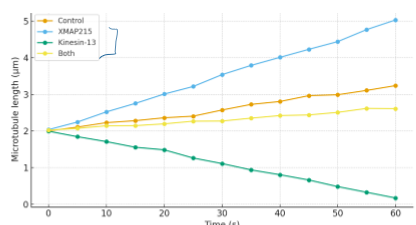
mt growth in vitro is controlled by different MT binding proteins. which of the following statements is best supported by the data?
XMAP215 acts as a MT polymerase that accelerates + end growth
kinesin-13 acts as a depolymerase that leads to MT shortening at the + end
when both proteins are present, their activities partially oppose each other producing a small new growth
which way does dynein move
toward the - end (nucleus)
which way does kinesin move
moving toward + end (away from nucleus)
how would you determine tha infection with Sars CoV-2 depends on transport along MTs
depolymerize MTs and look at the localization of the virus
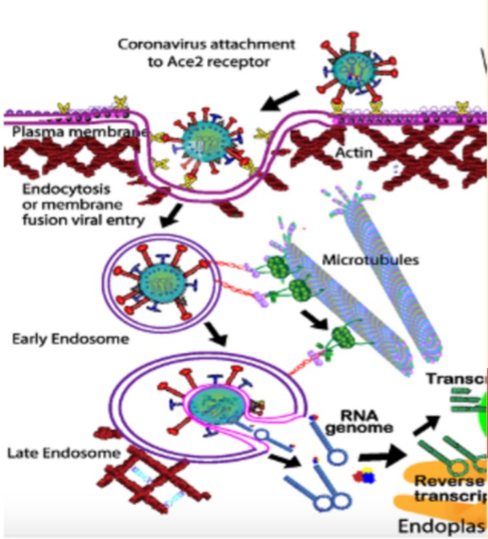
lamellipodium
at leading edge of a migrating cell
visualized by expression of gfp-tagged actin with FRAP
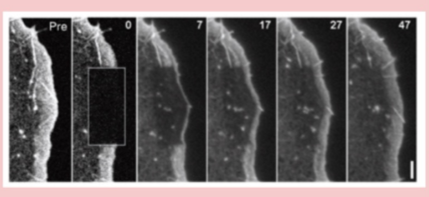
what do you conclude from a frap experiment
the lamelipodium is highly dynamic actin network
frap assess for movement/ dynamic behavior
not told what is being added/ removed
need to depolymerize to repalce parts of MT, then repolymerize it
which reagents would be suitable to generate this image? kintochores are shown in red, dna in blue, and MTs in green.
chicken anti-tubulin primary antibody, goat anti-chicken secondary with green fluorophore
mouse anti-kinetochore primary, goat anti-mouse with red fluorophore
MTs are made up of
tubulin heterodimers that consist of alpha and beta subunits
the GTP found in the a-tubulin subunit = non-exchangeable (fixed)
the gdp found in the B-subunit = exchangeable with soluble GTP
growth of a mt depends on
presence of a GTP cap
the slight delay between addition of subunits and GTP hydrolysis on B-tubulin lead to the GTP cap
GTP cap is NOT a capping protein for MTs (high enrichment of GTP subunits)
13 polar protofilaments form a MT
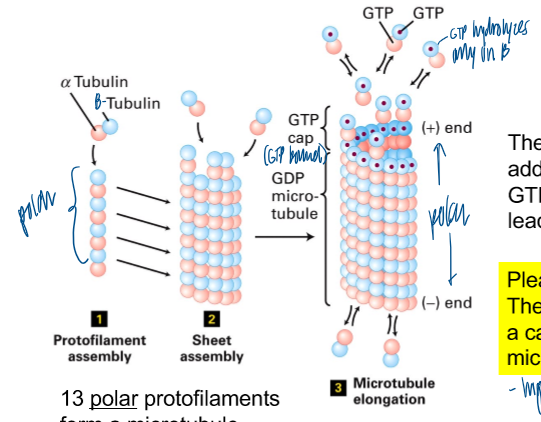
mts undergo
dynamic instability
tubulin GDP or GTP only refers to B-tubulin
no building block = no cap = fraying = depolymerization
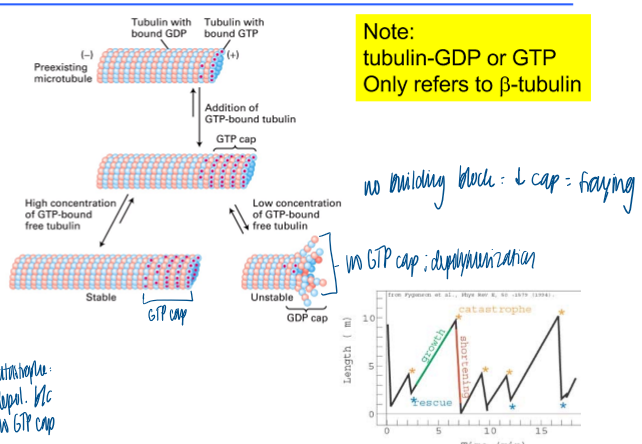
what controls mt dynamics
accessory proteins
gamma-TuRC
nucleates assembly and remains associated with the - end
increases growth
stathmin
binds subunits, prevents assembly
kinesin 13
enhances catastrophic disassembly at + end
destabilizes
katanin
severs microtubules
MAPs
stabilize tubules by binding along sides
XMAP215
stabilizes plus ends and accelerates assembly
+TIPs
remain associated with growing + ends and can link them to other structures, such as membranes
where are MTs nucleated
centrosome (=MTOC)
MTs radiate out
centroles (2 or 4, depending on the stage of the cell cycle)
pericentriolar matrix (PCM)
other sites of MT nucleation: Golgi
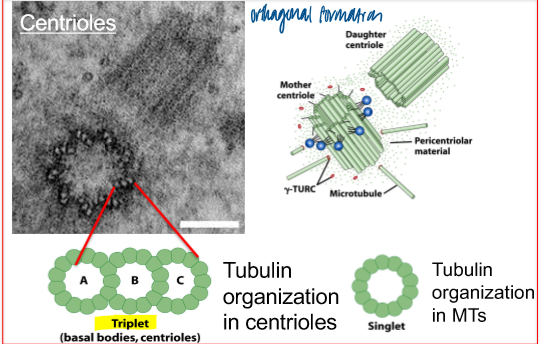
pericentriolar matrix (PCM)
200 - 400 proteins
ex: gamma-tubulin
another MT at centrosome
stabilizing = no depolymerization
(+) end binding protein
dynamically associates with the + end instead of the - end
kinesin-13
MT disassembling kinesin
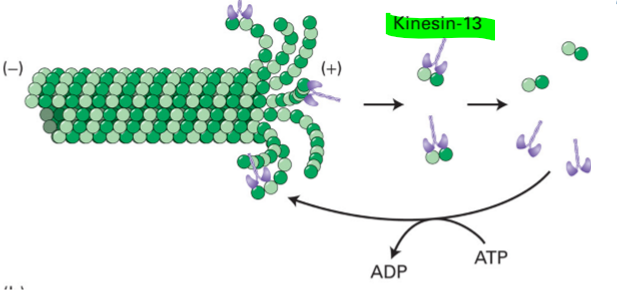
stathmin
MT destabilizing protein
promotes disassembly
nothing is added to (-) end because gamma-tubulin ring complex
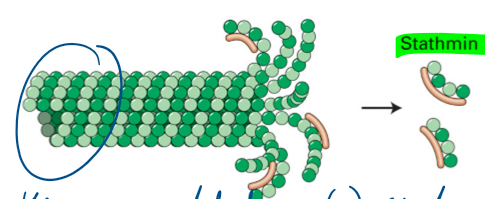
MT function
protein transport and organelle positioning
an efficient long range transport system is required
provide the tracks for motor-dependent transport to the axon terminal
kinesins
(+) end directed MT motor proteins
protein family with functionally diverse members
multimeric protein complex: 2 globular heads domains; ATP and MT binding; light chains → cargo binding
most kinesins mediate movement toward + end
requires ATP hydrolysis
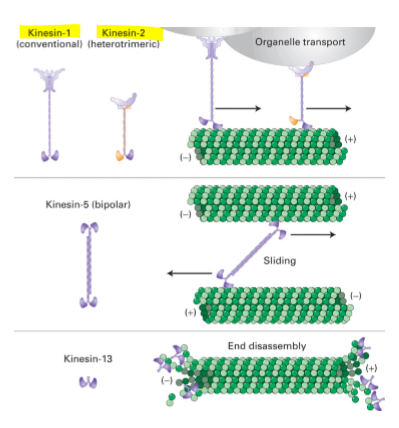
dynein
(-) end directed MT motor
very large protein
2 heavy chain with globular head domains → ATP and MT binding
movement requires ATP hydrolysis
cargo recog depends on the dynactin adaptor (multimeric complex)
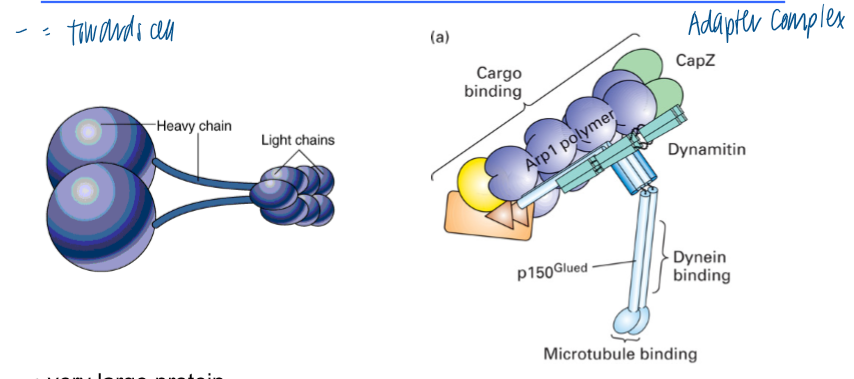
organelle positioning strictly depends on
functional MT motors
kinesin and ER membranes
kinesin moves ER membranes towards the plasma membrane
dynein and golgi membranes
dynein moves golgi membranes towards the cell center
MT formation
building block is a heterodimer composed of a and b-tubulin
gtp on b0tubulin is hydrolyzed during filament assembly (GTP on a-tubulin is not hydrolyzed)
GTP cap
GTP hydrolysis on b-tubulin occurs with a slight delay after subunit addition
with high conc of a/ b-tubilin heterodimer: GTP cap forms → MT growth
lack of GTP cap (due to low a/ B-tubulin conc: MTs undergo depolymerization)
dynamic instability of MTs
intrinsic property of microtubules
depend on the cytosolic conc of gtp-bound a/ b-tubulin heterodimer and the presence/ absence of the gtp cap
mt nucleation at the centrosome
> 50% of MTs are nucleated at the centrosome
their o ends are therefore capped and protected from depoly
because of this - end capping mech, treadmilling i sless important for MTs
positioning of organelles
depends on MT motor proteins
light chains or adaptors of these motor proteins are responsible for the selection of cargo (vesicles or organelles, such as the ER, golgi, or mito)
mt organization during interphase
radial array of MTs, nucleated at the centrosome
organelle positioning
vesicle transport
do not differ from thise nucleated at golgi vs centrosome
mt organization during mitosis
mitotic spindle, nucleated at the spindle poles (= centrosomes during mitosis)
chromosome segregation
mts are less stable in mitosis than in interphase, but how is this regulated?
kinesin-13, XMAP215
XMAP215 is phosphorylated in mitosis and p-XMAP215 cannot bind MTs
using energy efficiently to find chromosomes
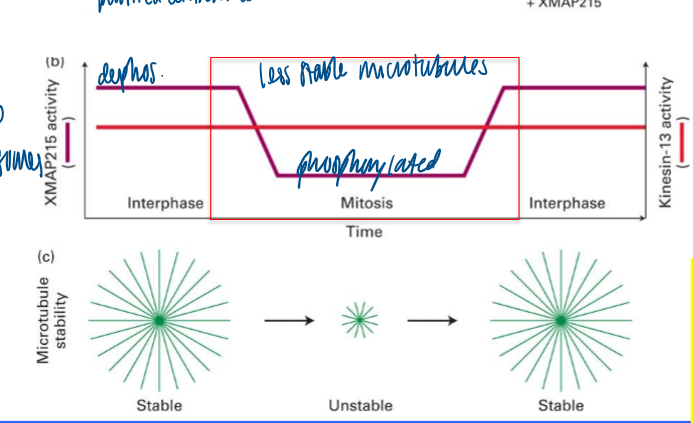
fluorescence recovery after photobleaching (FRAP)
determine the dynamic behavior of a structure
expression of gfp in the cell → photobleach
measure how fast the gfp signal recovers at the site of photobleaching
interpretation of frap results
fast recovery: protein is in exchange with another pool of the same protein (cytosol)
slow/no recovery: protein does not exchange with another pool of proteins because it is relatively immobile
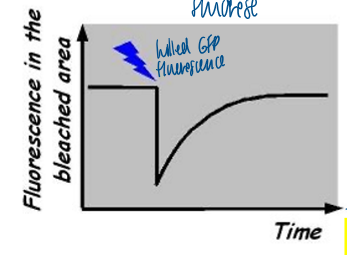
mitotic spindle
MTs form a complex structure during mitosis
3 different types of MTs in mitosis: astral MTs, kinetochore MTs, and interpolar MTs
characteristics of MTs in mitosis
decrease stability
enhanced nucleation
incraese in gamma tubulin in mito spindle
astral MTs
position spindle pole at one side of the cell
kinetochore MTs
pulling chromosomes to different sides
interpolar MTs
push spindle poles apart
taxol
chemotherapeutic that binds b-tubulin and prevents MT depolymerization
stabilizes the MTs
if they cannot depolymerize, tehy will grow and extend in one direction, then run out of building blocks → cell death
how do eukaryotic cells move
in a MT and dynein-dependent manner
“crawling” (development, infection, repair) →actin-dependent mechanism
swimming (sperm, protozoa, plasmodium)
flagellum of eukaryotic cells
MT-based structure
axoneme extends from mother centriole
9 microtubule doublets that surround a central pair of singlet MTs (axoneme can be very long: 10-200 um)
MTs are cross-linked with each other; dynein
motile cilia
cell surfance extensions related to flagella
same 9+2 organization as eukaryotic flagella, but shorter 200/cell
beat in synchrony to move fluid over surface (dynein-dependent = allow for movement)
present in resp system, repro tract, and CNS
disease: primary cilia dyskinesia (PCD) - impaired clearance of mucus and other particles
primary cilia
non-motile and function in signal transduction
present on most non-dividing cells (one per cell)
signaling organelle → contains many signaling molecules
no central MT pair (no dynein → not motile)
diseases: ciliopathies (polycystic kidney disease)
MTs during the cell cycle
dramatic reorg during cell division (centrosome-nucleated radial array in interphase vs mitotic spindle → blocking MT rearrangement is a powerful tool to block cell division → anti-cancer drug (taxol)
FRAP
method to measure the dynamic behavior of a protein
can be done in cells that express a gfp-tagged version of a protein of interest
laser-mediate photobleaching destroys the fluorophore so that gfp no longer fluoresces, but the protein remains intact and functional
measures how fast a protein is able to exchange with the same protein from a photobleached area
eukaryotic flagella overview
mediates movement of cells by a dynein and mt-dependent mech
9 mt doublets surrounding a central pair
ciliary dynein (2 or 3 heavy chains)
MTs are crosslinked so that atp-dependent dynein movement does not lead to MT sliding relative to one another, but to bending of the axoneme
cilia
similar to flagella, but shorter, defects are linked to human disease (motile and primary cilia